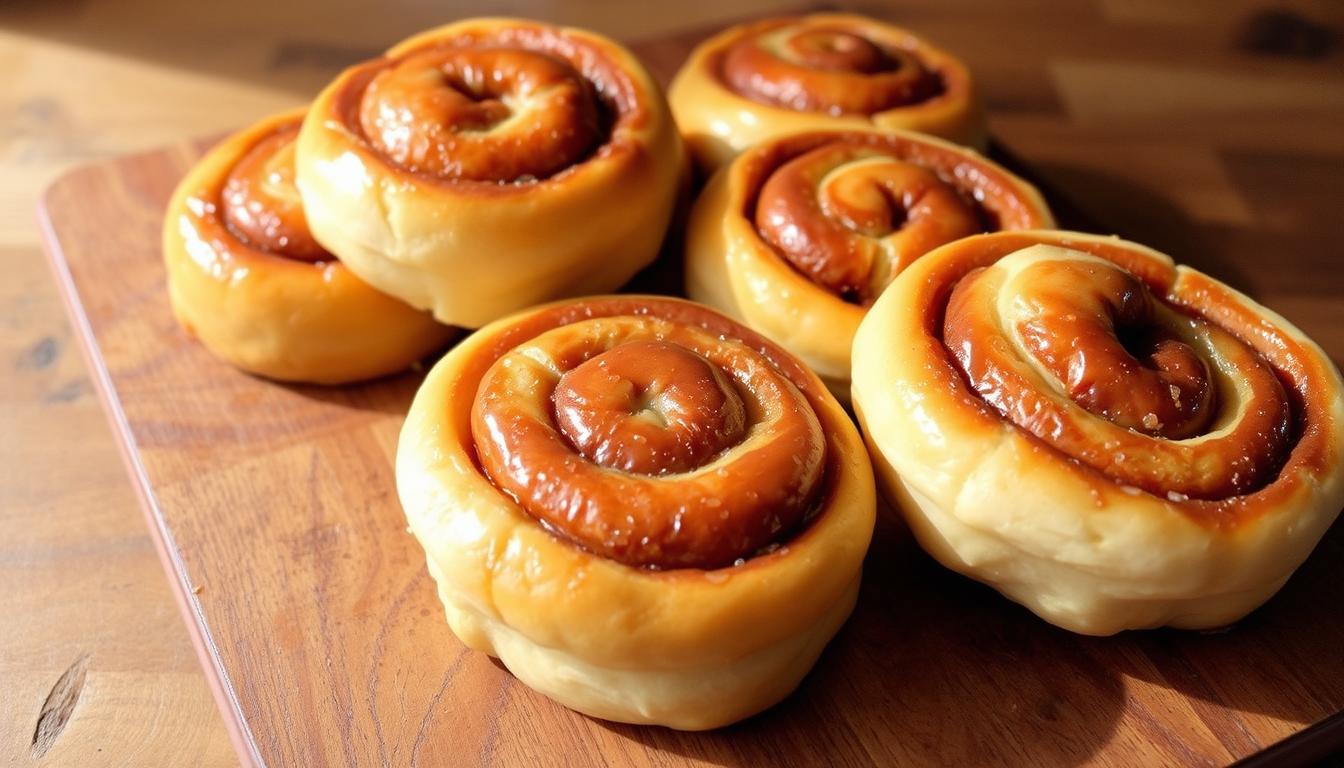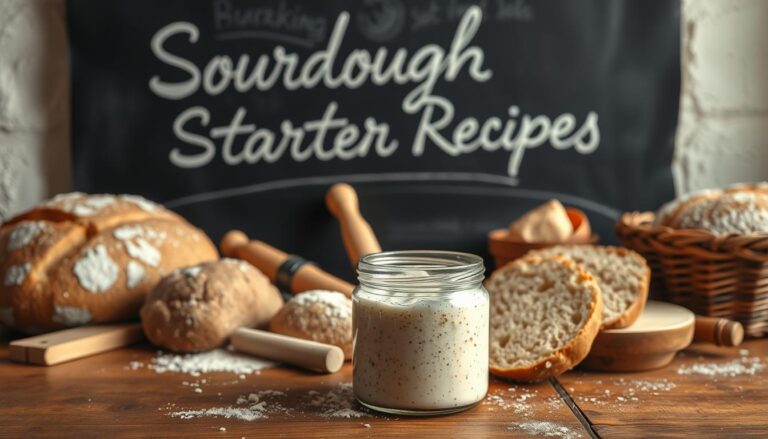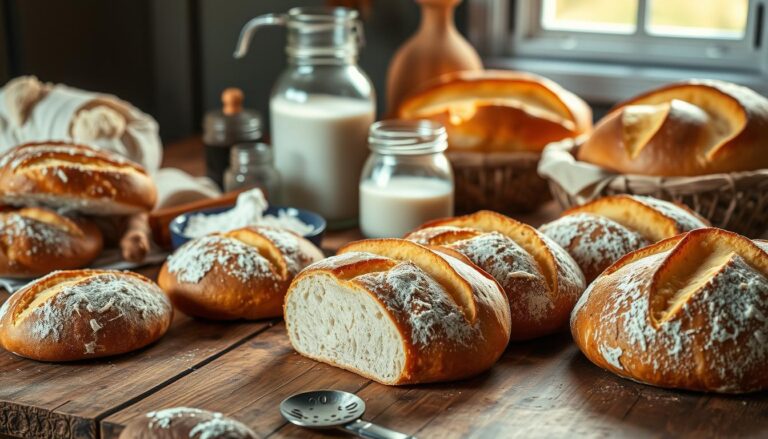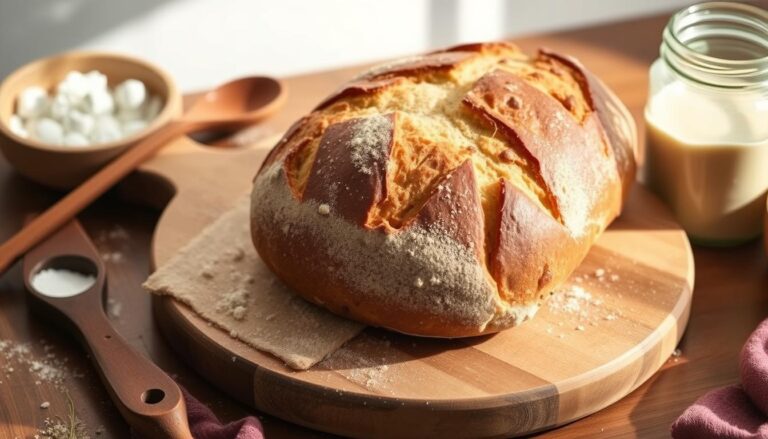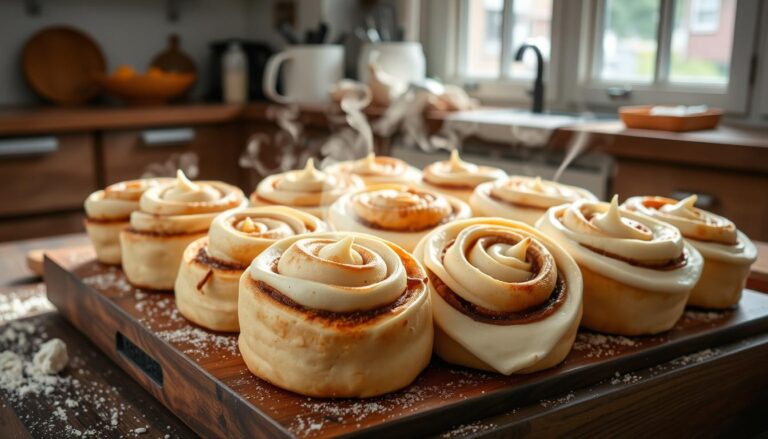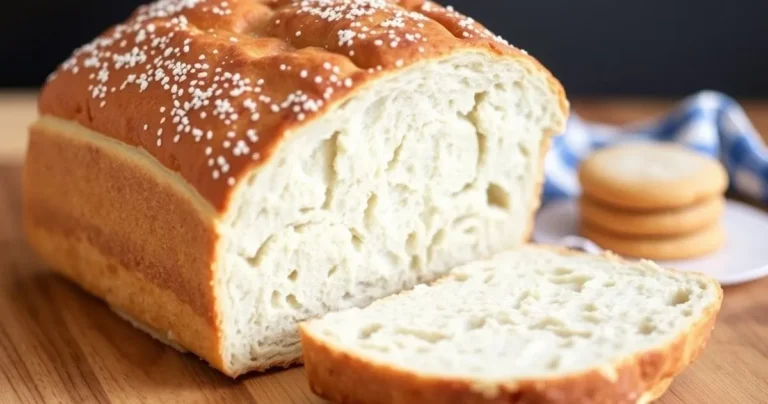Easy discard sourdough cinnamon rolls recip
Table of Contents
Easy sourdough discard cinnamon rolls recip
Do you remember the amazing smell of cinnamon rolls in your childhood home? That sweet, spicy scent was a promise of comfort in every bite. Now, imagine making that same feeling with your sourdough discard.
Turning waste into a breakfast treat is incredibly satisfying. These homemade morning rolls mix the best parts of traditional pastries with sourdough’s unique taste. They’re soft, buttery, and full of sugar, with a tangy twist.

Don’t worry if you’re new to baking with starter. This recipe is easy, requiring only basic kitchen skills. You don’t need an active starter to make these. They’re perfect for spontaneous weekend baking or busy mornings.
These swirled treats are easy to make and delicious. You’ll see how simple ingredients can become something amazing. Ready to make your leftover starter into something special? Let’s start!
What Is Sourdough Discard and Why Use It?
That jar in your fridge is full of sourdough discard. It’s a byproduct of sourdough care that can make your recipes special. This tangy mix is not waste but a chance to add unique flavors and textures to your baking.
Keeping a sourdough starter alive means you feed it regularly. You remove some starter to keep the right balance. This removed part is your discard.
Many bakers love using discard in recipes beyond bread. It adds a tangy taste to sweet treats like cinnamon rolls. It also makes baked goods moist and tender.
Using discard is a green way to bake. It reduces waste and makes flour nutrients easier to digest. The fermentation process starts breaking down flour, making it more digestible.
Understanding Sourdough Starter Maintenance
Keeping a sourdough starter healthy needs regular care. Most bakers feed it once a day at room temperature or once a week in the fridge. This keeps it active for baking.
It’s common to use a “100% hydration starter,” with equal flour and water. When you feed it, you usually discard 80% of it. This stops the starter from growing too much and keeps the right balance.
“The discard process isn’t about waste—it’s about balance. Without removing some starter during feedings, you’d quickly have enough sourdough starter to fill a bathtub!”
– Sarah Owens, James Beard Award-winning baker
Learning to bake with sourdough means knowing when your starter is ready. You also need to adjust feeding times based on your baking plans and the environment.
Benefits of Using Discard in Baking
Using sourdough discard in baking has many benefits. It adds a tangy flavor to your baked goods, especially in sweet treats. This flavor is a nice balance to sweetness.
Discard also makes your dough moist. This results in softer, more tender baked goods. These treats stay fresh longer than those made without discard.
| Benefit | In Bread Recipes | In Sweet Baked Goods | Nutritional Impact |
|---|---|---|---|
| Flavor Profile | Pronounced tanginess | Subtle complexity that balances sweetness | Enhanced taste without additional ingredients |
| Texture | Open, airy crumb | Tender, moist consistency | Improved mouthfeel and satisfaction |
| Digestibility | Partially broken down gluten | Easier to digest than conventional dough | Potentially better tolerance for sensitive individuals |
| Preservation | Natural mold inhibition | Extended freshness period | Reduced need for artificial preservatives |
From a nutritional standpoint, fermentation makes flour nutrients more available. The good bacteria in discard support gut health when eaten regularly.
By learning sourdough baking techniques, you can use discard in many recipes. This includes pancakes, waffles, cookies, cakes, and cinnamon rolls.
Why These Discard Sourdough Cinnamon Rolls Are Worth Making
These sourdough discard cinnamon rolls are a game-changer for breakfast. They mix practicality with indulgence, making them a must-try. Unlike regular cinnamon rolls, they turn waste into something amazing.
They’re quick to make, even on busy mornings. The discard adds depth without taking up too much time. This makes them both easy and gourmet.
Flavor Benefits of Sourdough in Sweet Baked Goods
The sourdough discard gives cinnamon rolls a unique taste. It balances the sweetness, creating a sophisticated flavor. Regular recipes can’t match this.
The acidity in sourdough enhances cinnamon spice. It’s like adding lemon to brighten flavors. This makes the rolls unforgettable.
The sourdough also improves the texture. It breaks down gluten, making the rolls soft but chewy. Each bite is perfect.
The best bakers understand that contrast creates complexity. The slight tang of sourdough against sweet cinnamon and sugar creates a depth of flavor that makes these rolls truly unforgettable.
Reducing Food Waste Through Creative Baking
Using sourdough discard for cinnamon rolls is a small step towards sustainability. It reduces food waste, making a big difference over time.
Think about it: a sourdough starter can produce 1 cup of discard weekly. That’s 52 cups a year! By using this discard, you’re making delicious treats and helping the environment.
This approach fits perfectly with conscious cooking. Many bakers feel proud to make sustainable choices. It’s a way to enjoy delicious breakfasts while caring for the planet.
| Aspect | Traditional Cinnamon Rolls | Sourdough Discard Cinnamon Rolls | Benefit |
|---|---|---|---|
| Flavor Profile | Sweet, one-dimensional | Sweet with tangy complexity | More sophisticated taste experience |
| Texture | Soft but sometimes dense | Tender with perfect chew | Improved mouthfeel and satisfaction |
| Environmental Impact | Standard ingredient usage | Reduces food waste | More sustainable baking practice |
| Preparation Time | Often requires long rise times | Quicker than traditional sourdough | More accessible for busy bakers |
These rolls turn waste into something special. They show that sustainable choices can also be delicious. They’re a perfect mix of practicality and indulgence.
Ingredients You’ll Need for Discard Sourdough Cinnamon Rolls
Let’s look at what you need to make delicious sourdough cinnamon rolls. This recipe is special because it uses your sourdough discard. It doesn’t need an overnight wait to start baking.
Each ingredient has a special job. They help make the dough, filling, and frosting. Knowing what each does will help you make the best rolls.
For the Dough
The dough mixes traditional ingredients with sourdough discard. This creates a perfect mix of texture and flavor. Here’s what you’ll need:
- All-purpose flour (4 cups/560 grams) – Makes the rolls soft and tender
- Baking soda (1 teaspoon) – Helps the dough rise quickly
- Baking powder (2 teaspoons) – Adds extra lift
- Salt (1 teaspoon) – Enhances flavor and controls yeast
- Sourdough discard (1 cup/227 grams) – Adds tang and texture
- Water (1 cup/236 grams) – Hydrates the dough
- Melted butter (1/2 cup/114 grams) – Adds richness
- Honey (1/4 cup/84 grams) – Adds sweetness and helps with browning
Make sure your sourdough discard is at room temperature. Adjust the water if it’s too thick or thin. You can also use whole wheat flour for a different taste, but you might need more water.
For the Filling
The filling makes these rolls special with its swirl and warm flavor. The right mix of butter, sugar, and cinnamon makes them gooey and sweet.
- Softened butter (1/2 cup/114 grams) – Makes the filling spreadable
- Brown sugar (1 cup/200 grams) – Adds sweetness and caramelizes
- Cinnamon (2 tablespoons) – Gives the rolls their flavor
Make sure your butter is soft, not melted. This helps the filling spread right. You can add nuts, raisins, or orange zest for different tastes. Use light or dark brown sugar for different flavors.
| Component | Key Ingredient | Function | Possible Substitution | Quality Tip |
|---|---|---|---|---|
| Dough | Sourdough Discard | Flavor and texture | None recommended | Use discard within 1-2 weeks of feeding |
| Dough | All-purpose Flour | Structure | Up to 50% whole wheat | Unbleached provides better flavor |
| Filling | Brown Sugar | Sweetness, caramelization | Coconut sugar | Fresh, soft sugar works best |
| Frosting | Cream Cheese | Creamy tanginess | Mascarpone | Full-fat provides best texture |
For the Frosting
The frosting is the final touch for your sourdough cinnamon rolls. It balances the sourdough’s tang with creamy sweetness.
- Cream cheese (6 ounces) – Adds tanginess
- Heavy cream (1/2 cup/120 grams) – Makes it smooth
- Maple syrup or honey (1/2 cup/168 grams) – Adds sweetness
- Vanilla extract (2 teaspoons) – Enhances flavor
For the cream cheese frosting, use room temperature cream cheese to avoid lumps. You can also use a simple glaze of powdered sugar, milk, and vanilla. Maple syrup or honey adds depth, but honey works too if you have it.
Equipment and Tools Required
Before starting your sourdough discard cinnamon roll journey, get the right tools. You don’t need a fancy kitchen to make these tasty treats. The right tools make the process easier and more fun. Let’s look at what you need to turn your discard into delicious rolls.

Essential Baking Tools
You’ll need some basic tools for your sourdough cinnamon rolls. A big mixing bowl is key for mixing and kneading the dough. You also need accurate measuring cups and spoons to keep the recipe balanced.
A rolling pin is a must for flattening the dough evenly. You’ll also need a sharp knife or dental floss for clean cuts. A silicone spatula is great for mixing and scraping. A baking dish or cast-iron skillet is perfect for letting your rolls rise and bake.
Optional But Helpful Equipment
Some tools are nice to have but not essential. A kitchen scale gives you precise measurements, leading to better results. A stand mixer with a dough hook attachment makes mixing and kneading easier.
A bench scraper helps with sticky dough and keeps your area clean. If you like making your own flour, a grain mill lets you customize. An immersion blender makes smooth cream cheese frosting without lumps. These tools can make your baking process more efficient, but they’re not necessary.
| Tool Category | Essential Items | Optional Items | Primary Function |
|---|---|---|---|
| Mixing | Large bowl, Spatula | Stand mixer | Combining ingredients and kneading dough |
| Measuring | Measuring cups/spoons | Kitchen scale | Ensuring accurate ingredient proportions |
| Shaping | Rolling pin, Sharp knife | Bench scraper, Dental floss | Creating and cutting perfect roll shapes |
| Baking | Baking dish/Cast-iron skillet | Parchment paper, Pastry brush | Providing proper baking environment |
Step-by-Step Discard Sourdough Cinnamon Rolls Recipe
Making homemade discard sourdough cinnamon rolls is easier than you think. This recipe guide will help you. It combines tangy sourdough flavor with sweet cinnamon goodness. Follow these steps to enjoy fresh-baked rolls quickly.
Preparing the Dough
Start by gathering all your ingredients and measuring them precisely. Accuracy is crucial for successful sourdough baking, especially with discard.
In a large mixing bowl, combine your dry ingredients: 2½ cups all-purpose flour, 1 teaspoon baking soda, 1 teaspoon baking powder, and ½ teaspoon salt. Whisk these together thoroughly to ensure even distribution of the leavening agents.
Next, melt 4 tablespoons of butter and set it aside to cool slightly. You don’t want it hot enough to kill the beneficial bacteria in your sourdough discard. While the butter cools, measure out 1 cup of sourdough discard, ¼ cup water, and 3 tablespoons honey.
Add all wet ingredients to your dry mixture: the sourdough discard, water, cooled melted butter, and honey. Mix everything together using a wooden spoon or stand mixer with a dough hook. Continue mixing for about 3-5 minutes until a cohesive ball forms.
The dough should be slightly tacky but not overly sticky. If it’s too wet, add a tablespoon of flour at a time. If too dry, add a teaspoon of water until you reach the right consistency.
First Rise and Dough Development
While this recipe uses chemical leaveners (baking soda and powder) for quicker results, a short rest period will still improve your rolls’ texture and flavor. Cover your dough with a clean kitchen towel and let it rest for 30 minutes at room temperature.
During this time, the sourdough discard will begin to interact with the other ingredients, developing more complex flavors. The gluten will also relax, making the dough easier to roll out in the next step.
This rest period is the perfect time to prepare your filling ingredients and lightly grease your baking dish. A 9-inch round cake pan or cast iron skillet works beautifully for these rolls.
Making the Filling
For the classic cinnamon filling, mix ¾ cup packed brown sugar with 2 tablespoons ground cinnamon in a small bowl. The brown sugar provides moisture and caramelization, while the cinnamon delivers that signature spicy warmth.
Melt 4 tablespoons of butter and let it cool slightly. The butter should be melted but not hot when you apply it to the dough. Too-hot butter can make the dough difficult to work with and might affect the rise.
For an extra dimension of flavor, consider adding ½ teaspoon of vanilla extract to your melted butter or incorporating ¼ teaspoon of nutmeg to your cinnamon-sugar mixture. These subtle additions can elevate your rolls from good to extraordinary.
Rolling, Filling and Cutting the Rolls
Lightly flour your work surface and turn out the rested dough. Using a rolling pin, work the dough into a rectangle approximately 12 inches by 16 inches, with a thickness of about ¼ inch. Try to maintain an even thickness throughout for uniform rolls.
Brush the entire surface of the dough with your melted butter, leaving a ½-inch border along one long edge. This border will help seal the roll when you’re finished rolling.
Sprinkle the cinnamon-sugar mixture evenly over the buttered surface, gently pressing it into the dough with your hands. Ensure even distribution for consistent flavor in every bite.
Starting from the long edge without the border, begin rolling the dough tightly toward the border edge. Keep the roll as tight as possible without stretching the dough. When you reach the border edge, pinch it gently to seal the roll.
Using a sharp knife or unflavored dental floss, cut the log into 9-12 equal pieces. For dental floss cutting, slide the floss under the roll, cross it over the top, and pull—this creates a clean cut without squishing the rolls.
Second Rise and Baking Instructions
Arrange your cut rolls in your prepared baking dish, leaving a small gap between each one to allow for expansion. Cover with a clean kitchen towel and let them rise for 30-45 minutes in a warm spot.
While the rolls are rising, preheat your oven to 375°F (190°C). The rolls are ready to bake when they’ve puffed up slightly and are touching each other.
Bake in the preheated oven for 20-25 minutes, or until the tops are golden brown and the internal temperature reaches 190°F (88°C). If the tops are browning too quickly, loosely cover with aluminum foil.
Allow the rolls to cool in the pan for 5-10 minutes before frosting. This cooling period lets the rolls set up while still being wonderfully warm when served.
| Feature | Traditional Cinnamon Rolls | Discard Sourdough Cinnamon Rolls | Benefit |
|---|---|---|---|
| Preparation Time | 3+ hours | 1.5-2 hours | Quicker results |
| Flavor Profile | Sweet, one-dimensional | Sweet with tangy complexity | More interesting taste |
| Digestibility | Standard | Improved | Easier on the stomach |
| Food Waste | None reduced | Reduces starter waste | More sustainable baking |
Troubleshooting and Tips for Perfect Cinnamon Rolls
Making perfect sourdough discard cinnamon rolls can be a challenge. Even skilled bakers face problems sometimes. Knowing common issues can help you get better results and avoid failures. Let’s look at common problems and their fixes, along with expert tips to improve your cinnamon rolls.
Common Mistakes to Avoid
One big mistake is cutting the rolls unevenly. This leads to some being overcooked and others not done enough. To avoid this, use a ruler or mark the dough before cutting.

Getting the ingredients right is key. Too much flour makes rolls dense, while too little makes them sticky. Always use a kitchen scale for accurate measurements.
Don’t overwork the dough. This makes rolls tough instead of soft. Stop kneading when the dough is smooth and elastic.
Wrong oven temperature can ruin your rolls. Too hot burns the outside before the inside is cooked. Too cool prevents them from rising. Use an oven thermometer to check your temperature.
Rolling out the dough can be tricky. Use a bench scraper to gently lift the dough without tearing it. This tool can save your dough and reduce stress.
| Problem | Cause | Solution | Benefit |
|---|---|---|---|
| Uneven baking | Inconsistent roll sizes | Use measuring tools when cutting | Uniform doneness |
| Dense rolls | Too much flour | Weigh ingredients precisely | Light, fluffy texture |
| Tough texture | Overworked dough | Handle dough minimally | Tender, soft rolls |
| Filling leakage | Loose rolling technique | Roll tightly and seal edges | Neat, contained filling |
Ignoring room temperature ingredients can also cause problems. Cold ingredients slow down yeast activity. Plan ahead to prevent waste from failed batches.
Expert Tips for Soft, Fluffy Rolls
The thickness of your dough affects the texture. For more layers, roll the dough thinner (about ¼ inch). This creates a beautiful spiral effect and ensures even filling distribution.
The secret to truly exceptional cinnamon rolls lies in the patience you give them. A slower rise develops more complex flavors and better texture than rushing the process.
Where you place your rolls in the baking dish matters. Rolls close together (about ½ inch apart) will have softer sides. For a defined crust, space them 1-2 inches apart.
For exceptionally soft rolls, try the tangzhong method. Cook a small portion of flour with liquid before adding it to your dough. This keeps the rolls moist and fresh, reducing waste.
Adjusting to your kitchen environment is key for consistent results. In dry climates, reduce flour slightly or add extra liquid. In humid environments, add more flour for the right dough consistency.
If your dough isn’t rising, create a warm spot. Place the covered bowl near a warm oven or in a turned-off oven with just the light on. This warmth helps yeast activity without harming your sourdough discard.
Brushing your rolls with melted butter after baking adds flavor and softens the crust. This step makes your homemade treats taste like they came from a bakery and prevents the crust from drying out too fast.
Storage and Serving Suggestions
Knowing how to store and serve your homemade sourdough cinnamon rolls can make them last longer. This way, every bite stays as tasty as when they first came out of the oven. Let’s look at the best ways to keep your rolls fresh and creative ways to serve them.
How to Store Sourdough Cinnamon Rolls
Storing your sourdough cinnamon rolls the right way keeps them fresh and tasty. For unfrosted rolls, put them in an airtight container at room temperature. They’ll stay fresh for 2-3 days. This keeps them from drying out and protects them from moisture.
If your rolls have frosting, refrigeration is best. Store frosted rolls in a sealed container in the fridge for up to 4 days. The cold keeps the frosting from spoiling and the rolls’ structure intact.
Avoid plastic bags to prevent rolls from getting soggy. Use containers with good seals for minimal air exchange. If rolls get hard, warming them in the microwave for 10-15 seconds will make them soft again.
Freezing and Reheating Methods
Freezing is great for keeping baked goods fresh for longer. Cool your rolls completely before freezing. Freezing them before adding frosting is best, but frosted rolls can be frozen too.
Wrap each roll in plastic wrap or parchment paper before freezing. This prevents them from sticking together. Frozen rolls stay good for up to 3 months.
When you’re ready to enjoy them, you have several reheating options:
- Thaw overnight in the fridge, then warm in a 300°F oven for 10-15 minutes
- Reheat from frozen in a 325°F oven for 20-25 minutes
- Microwave individual thawed rolls for 20-30 seconds
Add fresh frosting after reheating for the best taste. Frozen frosting can get runny when warmed.
Best Ways to Serve Your Homemade Rolls
Sourdough cinnamon rolls are best when served warm. This lets their spices and gooey centers shine. Warm your rolls in the oven for 5-7 minutes for a special breakfast or brunch.
Pair your rolls with drinks for a better experience:
- Hot coffee or espresso balances the sweetness
- Warm milk enhances the cinnamon’s warmth
- Hot chocolate adds a rich layer of indulgence
Don’t throw away stale baked goods. Instead, use them in new ways. Cube day-old rolls for a tasty bread pudding, or slice and toast them for French toast. You can also crumble them as a topping for ice cream or yogurt parfaits.
For a fancy touch, drizzle warm rolls with frosting or caramel sauce before serving. Sprinkle chopped nuts on top for extra flavor and texture.
Conclusion
Making discard sourdough cinnamon rolls is a fun way to use up extra starter. These rolls are soft, buttery, and full of cinnamon. They bring a perfect mix of sourdough tang and sweet to your breakfast.
This recipe is practical. Instead of throwing away your discard, you make twelve big rolls. These rolls are great for feeding a family or sharing with friends. The sourdough adds a unique twist to the classic cinnamon roll taste.
These rolls are easy to fit into your baking schedule. Once you learn the basic recipe, try new things like orange zest in winter or fresh berries in summer. You can also experiment with different spices in the dough.
These rolls freeze really well, so you can enjoy them whenever you want. Just thaw and warm them up, and your kitchen will smell amazing again.
Ready to make these cinnamon rolls? Get your mixing bowl and rolling pin ready. Your kitchen will smell incredible, and you’ll be glad you didn’t throw away that discard starter!
FAQ
Can I use active sourdough starter instead of discard for this recipe?
Yes, you can use active sourdough starter instead of discard. You might need to adjust the flour and liquid ratios a bit. Active starter is bubbly and can make the dough rise more, possibly needing less baking powder or soda. The flavor will be less tangy than with discard.
How long can I store sourdough discard before using it in this recipe?
You can store sourdough discard in the fridge for 1-2 weeks. For longer storage, freeze it in small portions for up to 3 months. Thaw it in the fridge overnight before using. The older discard is, the tangier it gets, adding interesting flavors to your cinnamon rolls.
Do these cinnamon rolls need to rise overnight like traditional sourdough recipes?
No, these cinnamon rolls don’t need an overnight rise. They use baking powder and soda, along with the discard, for leavening. This means you only need a short rest of 30-60 minutes for the dough to relax and flavors to develop. They’re quicker to make than traditional sourdough recipes.
Can I make these cinnamon rolls dairy-free?
Yes, you can make them dairy-free. Use plant-based butter and milk alternatives for the dough. For the filling, use plant-based butter and keep the brown sugar and cinnamon the same. For the frosting, use a glaze with powdered sugar and plant milk, or find a dairy-free cream cheese alternative.
Why are my cinnamon rolls dry?
Dry cinnamon rolls often come from overbaking, too much flour, or not enough fat in the dough. Make sure to measure your flour correctly and include all the butter called for. Watch your baking time closely. Also, try placing a pan of water on the bottom rack of your oven to keep the rolls moist.
Can I prepare these rolls the night before and bake them in the morning?
Yes, you can prepare them the night before. After cutting and arranging, cover them tightly with plastic wrap and refrigerate. In the morning, let them come to room temperature for 30-45 minutes before baking. This cold fermentation enhances the flavor, making the rolls even more delicious.
How can I tell when my cinnamon rolls are perfectly baked?
Perfectly baked rolls are golden brown on top and have an internal temperature of about 190°F (88°C). If you don’t have a thermometer, a toothpick inserted into the center should come out clean or with a few moist crumbs. They should also feel set when lightly pressed in the center.
What’s the best way to reheat leftover cinnamon rolls?
Reheat leftover rolls in a 300°F (150°C) oven for 5-7 minutes to restore their softness. For a quicker option, microwave individual rolls for 15-20 seconds. To prevent drying, place a small cup of water in the microwave with the roll. For frozen rolls, thaw them overnight in the fridge before reheating.
Why did my filling leak out during baking?
Filling leakage usually happens when the butter is too warm or melted before rolling. Use softened but still solid butter for the best results. Also, roll the dough tightly and place the rolls close together in the baking dish. This helps keep the filling inside.
How can I repurpose stale sourdough cinnamon rolls?
Stale rolls can be turned into delicious bread pudding. Cut them into cubes, soak in a mixture of eggs, milk, vanilla, and cinnamon, then bake until set. You can also make French toast by dipping slices in an egg mixture and pan-frying. Or, create cinnamon roll trifles by layering pieces with whipped cream and fruit. These methods reduce waste and create new desserts.

